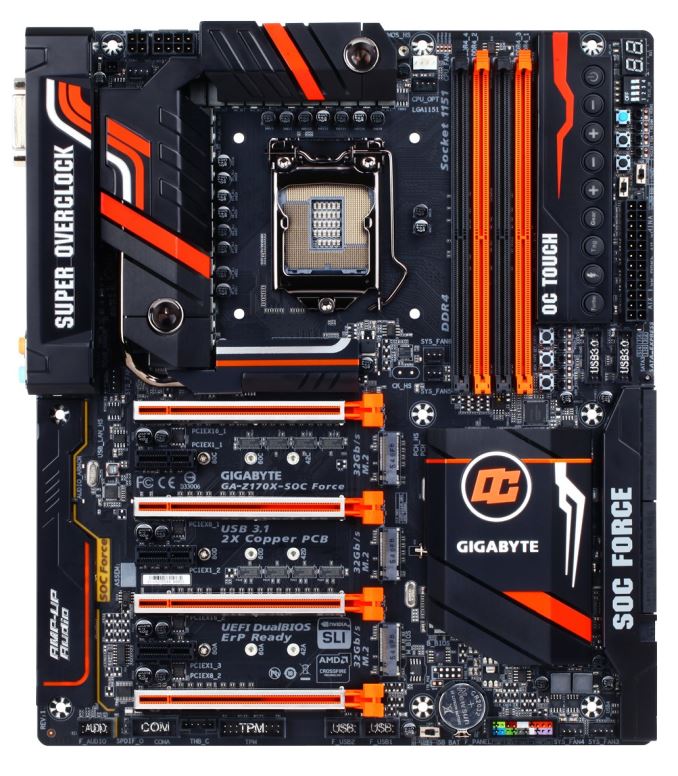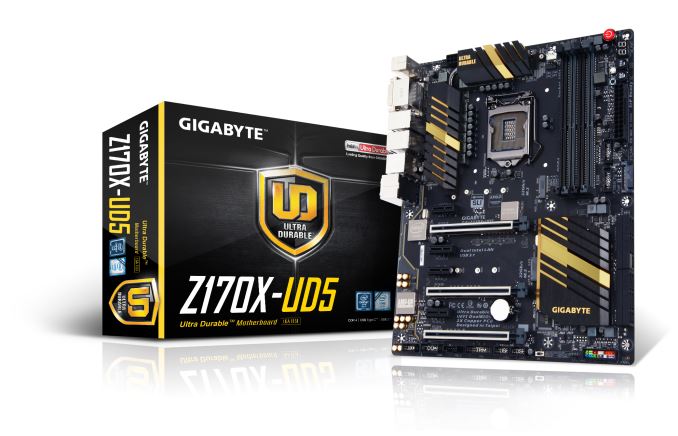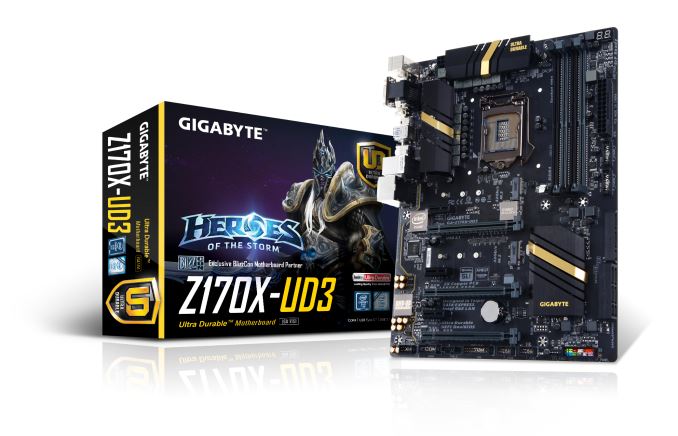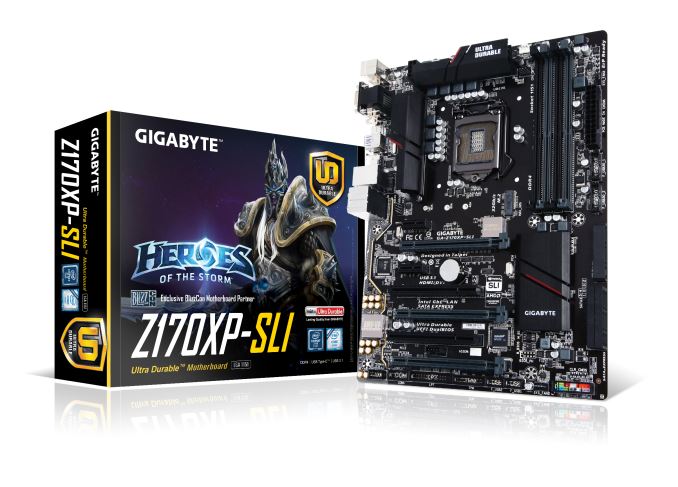Intel Skylake Z170 Motherboards: A Quick Look at 55+ New Products
by Ian Cutress on August 5, 2015 7:59 AM ESTGIGABYTE Z170: Super-Overclock and Ultra Durable
GIGABYTE Z170X-SOC Force
We’ve tracked GIGABYTE’s overclocking motherboards over the years, and interviewed motherboard product manager Jackson Hsu at the height of the Z87X-SOC launch when they were selling SOC motherboards quicker than they could be made. GIGABYTE tends to make anywhere from one to three overclocking models, including an ‘everything’ board and a ‘stripped’ version for extreme overclockers. At this point, the ‘everything’ board is the one being focused on.
We don’t have much information about the SOC Force at this time, but it is clear that the Force and the G1 are both aiming for the high end of their markets respectively. Similar to the G1 the power delivery heatsink is an air/water combination that stretches around the board. The SOC Force also has a 16+4+2 phase power arrangement, and under that second heatsink is also a PLX chip to allow for four-way SLI with x8/x8/x8/x8. The PCIe slots are also shielded to prevent damage, and between the slots are four separate M.2 PCIe 3.0 x4 slots.
The SOC Force as a whole moves into the E-ATX form factor, expanding to the right due to the OC Panel next to the DRAM slots. In an update to the design, rather than the previous array of buttons on the PCB they now have a cover with a large number of options beside it still. These options are for the extreme overclocking crowd, and no doubt GIGABYTE will be trying to challenge for records for the longevity of the platform.
The expanded PCB helps other features to fit on, such as the 8 SATA ports with the tri-SATA Express arrangement similar to the Gaming motherboards. For USB 3.1, the SOC Force has a Type-C and a Type-A on the rear panel, though at this time it is unclear if we are using the ASMedia ASM1142 or the Intel Alpine Ridge controller. The network controller is the Intel I219-V, escaping the clutches of the Killer line.
GIGABYTE has previously loved to play in the cheap overclocking space for mainstream platforms, and although we don’t have any information on a sub-$200 product coming, I would be surprised if one was not in the works.
GIGABYTE Z170X-UD5 - MSRP $190
GIGABYTE’s regular home-build motherboards form the Ultra Durable line, coming with a designation from UD3 to UD9. At this point in time only the UD3 and UD5 have been announced, and both look more like run-of-the-mill motherboards compared to their gaming counterparts. The styling is less garish with fewer custom LEDs or loud colors. That being said, both of them have similar hardware arrangements to the gaming line with the gaming parts replaced.
As a result, the UD5 here has a double Intel network solution, an enhanced Realtek ALC1150 audio orientation and standard three-way graphics support via x8/x4/x4. The PCIe shields are here by virtue of their use in actually supporting the PCIe slot rather than a gaming function. GIGABYTE is still using the Alpine Ridge controller for the USB 3.1 ports, here giving a USB 3.1-C and a single USB 3.1-A. There is no HDMI 2.0 on the UD5.
Storage comes via eight SATA ports, three SATA Express ports and the two M.2 slots in the middle of the board that run at full PCIe 3.0 x4 bandwidth. Given the UD5’s positioning, we might see it being bundled with an M.2 to U.2 converter – or if a UD7 comes out later, it might be added there.
GIGABYTE Z170X-UD3 - MSRP $165
The UD3 removes the PCIe metal shielding and dials down the heatsink styling again to a more reserved black and slightly gold look. We move down to a single network port, two fewer SATA ports and replace the DisplayPort with a VGA connector, but keep dual M.2 slots, the Alpine Ridge based USB 3.1 A+C combination and an x8/x4/x4 PCIe arrangement. The audio is also still GIGABYTE’s upgraded Realtek ALC1150 solution.
GIGABYTE Z170XP-SLI - MSRP $150
There also tends to be a model at the bottom of the Ultra Durable stack specifically for SLI. While not called ‘UD’ by name, the Z170XP-SLI carries the branding:
The Z170XP-SLI is the UD3 with even less styling on the power delivery, namely because the power delivery is dialed back for fewer phases. One of the internal PCIe 3.0 x1 slots also changes to a PCI slot by way of a bridge chip. This also seems to be the point where GIGABYTE changes to the ASMedia ASM1142 controller for USB 3.1 ports, and providing the A+C combination as before.
GIGABYTE Z170-D3H ($115) / Z170-HD3 ($115) / Z170-HD3P ($125)
The rest of the channel line we have information on focuses on the ‘3’ part of the product line, and as such aims for base functionality of the chipset with a few added extras with each name suggesting a different added feature that the others do not have. In this case, the D3H has an upgraded audio and Intel network controller while the other two have Realtek, and the HD3 is the one without USB 3.1 from the ASMedia controller. All three of these boards have a single PCIe 3.0 x16 and typically an x1 or x4 from the chipset, meaning that SLI will not work on them.

























_thumb.jpg)






_thumb.jpg)








85 Comments
View All Comments
Oyster - Wednesday, August 5, 2015 - link
Ian, do you think it is possible to supply us with a tabular breakdown of all the motherboards? Not sure about others, but going through page-by-page is a bit overwhelming, and confusing at the very least. Good coverage as usual!Eidigean - Wednesday, August 5, 2015 - link
I second this. looking for number of M.2 slots, PCIe slots, USB 3.1 ports w/ type of controller (Alpine or otherwise). I'm shocked so few support 3 M.2 slots.MrBowmore - Wednesday, August 5, 2015 - link
Why not just use the pcie? Is there anything better than a intel 750 and demands M.2? I dont get the need for M.2.Eidigean - Wednesday, August 5, 2015 - link
Well, the SM951 is quite interesting. Also, if the M.2 slots are used, the PCIe slots can be used for 4 GPUs, NICs, or RAID cards. The ASUS workstation board in this article is interesting.Gadgety - Wednesday, August 5, 2015 - link
Tabular would be great.The_Assimilator - Wednesday, August 5, 2015 - link
Z170X-UD5 and Z170X-UD3 galleries are swapped.I'm glad to see that Gigabyte is exposing 2x USB 3.0 internal headers on almost all their boards - USB 2.0 needs to die. Now if only they would replace the dual USB 2.0 headers with an additional 3.0, giving 3x USB 3.0 headers, then I would be ecstatic. My Z77X-UD5H is still the only decently-priced motherboard around with a trio of USB 3.0 headers, and it's not getting any newer!
Regardless, I'm probably going to skip Skylake, for the simple reason that I'm not interested in buying a board equipped with the useless SATA Express. By the time Cannonlake rolls around, M.2/NGFF should have killed SATAe and there will be even more USB 3.0 ports from the chipset.
DanNeely - Wednesday, August 5, 2015 - link
I bought a GB board for a 4790k earlier this year for the dual headers. At least in the medium term though, I think they do need to keep 1 or 2 2.0 headers around. Not everyone buys a new case for their new builds, and older cases have built in 2.0 ports on the front/top panel. The same thing for front panel SD card readers; there are USB 3.0 versions out now, but the SD reader won't benefit from the faster connection so why spend money to replace it. I can't remember who makes it, but there's one OEM who sells some PSUs with an internal USB2 header for monitoring purposes.Beyond all of that, the chipset itself provides 14USB ports only 10 of which can be 3; so the mobo makers have 2 "free" headers to do something with. Dell/HP/etc will ignore them; but in the box ticking consumer market they're going to get used either for internal headers or a pairs of ports in the back. Anyone clinging to w7 who doesn't have PS2 peripherals in the closet will need those since 7 doesn't have a USB3 class driver; and at least in my case refused to talk to a 2.0 device in a 3.0 port until I got drivers installed.
Impulses - Thursday, August 6, 2015 - link
If you're using an SD reader for a modern camera with modern SD cards then it'll absolutely benefit from USB 3.0... Last 128GB SD I bought for like $58 can read at 150MB/s (or about 3x USB 2.0 speeds), Lexar UHS-II card. Most recent mirrorless bodies can take advantage of it too...8steve8 - Wednesday, August 5, 2015 - link
when will these actually be for sale?Ian Cutress - Wednesday, August 5, 2015 - link
Depends on the motherboard and what region you are in, but some are listed already: http://www.amazon.com/s/ref=nb_sb_noss?url=search-...